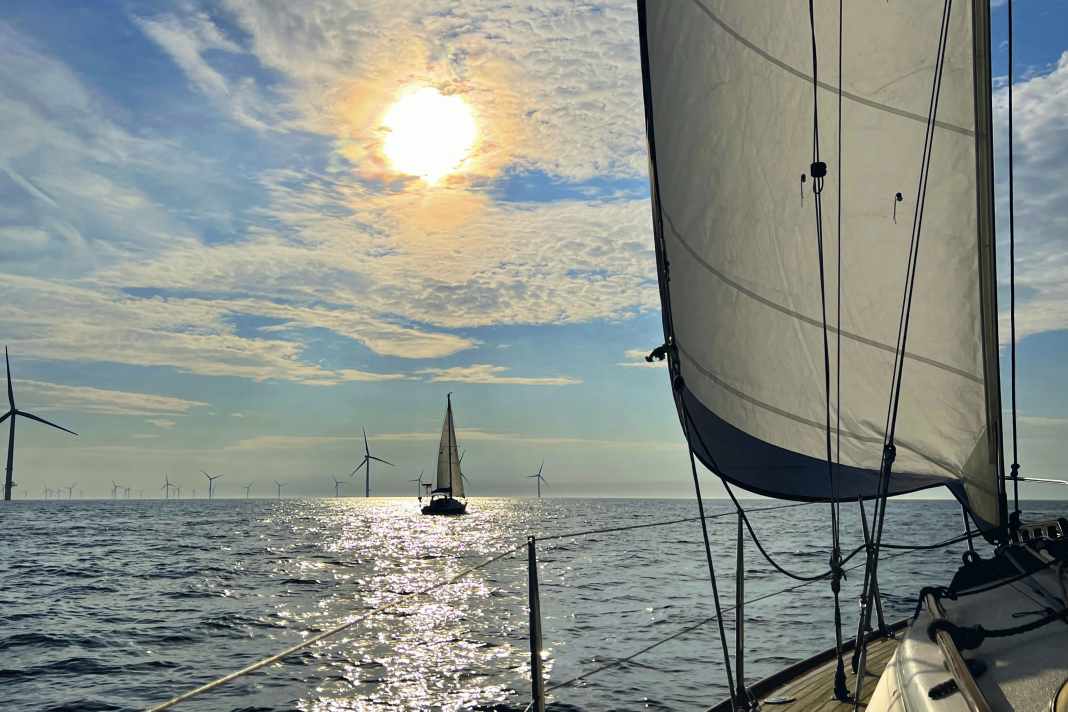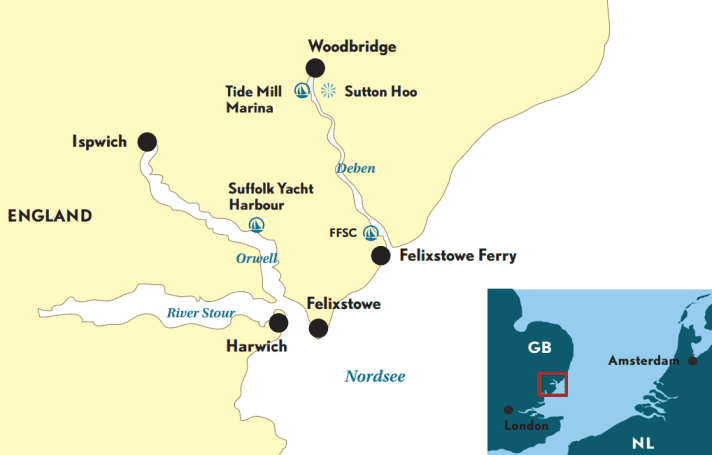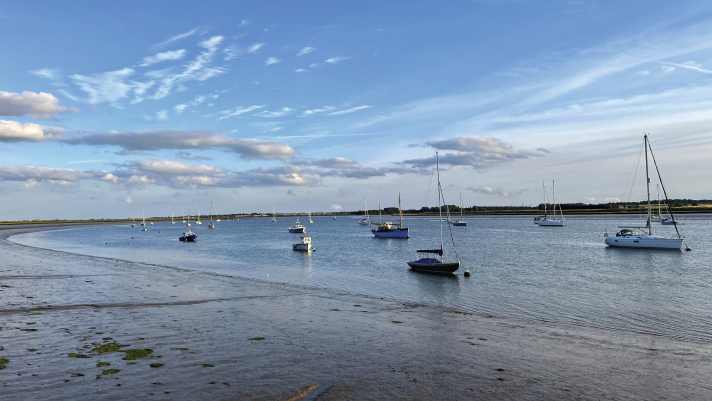





A clear voice breaks through the sonorous hum of the diesel in the dusk: "'Naja', 'Naja', this is Netherlands Coastguard." No answer. A short time later, the call is repeated. Again no answer. Then it's our turn: "'Valentine', 'Valentine', this is Netherlands Coast guard." We reply: "Netherlands Coastguard, 'Valentine'." The man from the coastguard wants to know if we are aware that we have just left the corridor that leads through the huge Borssele wind farm a good 20 nautical miles off the coast of Walcheren in the south of the Netherlands. Well, the truth is: halfway.
Flotilla trip to Felixstowe
Of course, the plotter clearly shows that we are travelling on the edge of the permitted route. But because we are almost through and then have to turn south anyway, we may have got a little too close to the limit. Or possibly even beyond it. But the coastguards certainly don't care. So I explain that the tide must have shifted us a little - which is true - and that we hadn't noticed - which, admittedly, isn't true. They are satisfied with the assurance that we will change course immediately. However, we are still asked whether we can persuade the "Naja" to change course. We can, because: We are travelling together. Our destination: Felixstowe on the east coast of England.

With three beeps, the autopilot confirms the course change and we leave the not entirely legal area of the wind farm. It's nice that the Coastguard pointed out our misbehaviour and didn't immediately impose a fine. The journey began many months earlier, and as is so often the case, with an idea. Helge von der Linden, head of the Wesel Yacht Club, called at the time: "You, on the occasion of the 50th anniversary of the town twinning between Wesel and Felixstowe, we want to organise a flotilla trip there. From there, I want to travel a little further up the River Deben to Woodbridge. That's where my boat was built." Would I like to come along? I didn't think twice: absolutely! Firstly, because holidays with Helge and his wife Dorothea are always very relaxed. And secondly, I've wanted to go to the island for ages. But it's never worked out so far. Now the opportunity has arrived. Sailing mate Karsten spontaneously hired me on board for the trip.
Obstacles on the road to Felixstowe
We set off in mid-July. We meet in Zierikzee on the Oosterschelde. Five days later, the anniversary celebrations in the English twin town are due to begin. Unfortunately, there is far too little wind and we set off. Two large wind farms, various traffic separation schemes, the tidal current and some shallows off the English coast have to be mastered one by one. Perhaps it's just as well that it's not blowing at 20 knots.
So after 22 hours we chug into the River Orwell. The current runs as predicted. First we pass the impressive harbour facilities of Felixstowe. We then leave the famous Shotley Marina on our port side, as well as the well-known fish and chips paradise "Butt and Oyster" in Pin Mill. Our destination is Suffolk Yacht Harbour. Two other boats that are also taking part in the flotilla are already waiting for us here. One had started in Stellendam on the Haringvliet, the other, a motor yacht, came from IJmuiden.
One call is all it takes to clear in
Of course, the yellow quarantine flag flies under the spreader. Without it, you are not allowed to call at England from the EU. Furthermore, the passage plan must be submitted to the authorities beforehand. As well as the most important data of all crew members. On site, we were told, customs would then come on board, and after clearing in, we would be allowed to move around freely. When asked about this, however, the harbour master just laughs: "You just have to call them, then you're usually already cleared." And that's exactly how it is: one phone call and we've officially entered the country.
In the evening, we join the other crews for a welcome dinner at the yacht club in the harbour. Also there: Andy Robinson from Felixstowe Ferry Sailing Club. He is the club's yacht captain and owns a yacht himself. Andy tells us about the entrance to the River Deben, where the clubhouse of the Wesel sailing club's partner organisation is located. He advises that there is a large and variable bar in front of the river, which is best avoided if there is too much wind. Two days later, the conditions are good: little wind and high water at a Christian hour. We enter the quaint river that is so typical of the English east coast.
Long partnership
Sightseeing in Felixstowe is on the programme for the next day. Then a football match between Germany and England is scheduled. Fortunately, delegates from other clubs have travelled from Wesel; football is somehow not for sailors. In the evening, the Ferry Boat Inn, the "FBI" as the locals call it, is the place to discuss the crossing in detail over excellent English food and delicious ale.
The visit to the impressive fort in the afternoon, which had to protect the harbour and the entrance to the River Orwell during the Second World War, among other things, had previously made it clear how important town twinning still is today. It all began 50 years ago with an exchange of firefighters from the two cities. Since then, the partnership has become a reality on many levels. The Wesel Yacht Club and the Felixstowe Ferry Sailing Club have also been linked for some time.
The von der Linden family has always run a marine accessories business in Wesel, which has developed into one of the top addresses for innovative boatbuilding materials over the years. At the time, the aim was to show what the new epoxy resin material was capable of. A suitable type of boat was needed for demonstration purposes. Through the town twinning programme, contact was made with a shipyard in Woodbridge on the River Deben, which was looking for a representative abroad. The shipyard then built the very "Naja" with which Helge and Dorothea von der Linden have now travelled to the Deben again.
Once the boat is under construction, it becomes clear that both sides are enthusiastic about sailing and youth work. People stay in touch and friendships develop between the club members in the years that follow.
Old beer barrels as fenders
One person who witnessed all of this from the very beginning is Palm Heise. The 86-year-old couldn't resist travelling to the event by boat. It was important to him to pay his respects to his friends from the FFSC. He knows many of the members of the English club personally. Several years ago, he sailed here in his old shrimp cutter on his own keel, back then as a delegation from the Wesel club. The family that used to own the Diebels brewery was also a member of the club. They therefore took a few barrels of Altbier with them as a gift. It is rumoured that the crew hung them outboard on arrival and declared them as fenders so as not to attract attention at customs.
These anniversary days are characterised by cordiality. Sometimes even official: jackets and ties are worn, at least by some. The crew of the "Valentine" miss out on the official character of the Sunday lunch and are rescued by the Commodor of the English club: She also comes in shorts. The traditional Sunday Roast, on the other hand, is formal. You can feel how important this meeting is to those present and how much they want to continue to fill the partnership with life.
There are no big speeches, however, as that would not suit either the boss of the Weselers or the Commodor of the English. Instead, we eat, chat, chat and laugh together. A marvellous afternoon in the clubhouse with a direct view of the entrance to the Deben. The German delegation had mastered this in the morning without any problems. The buoyage had recently been adjusted, and the Felixstowe Port website shows the exact depths almost by the minute. And we had a local pilot with us.
Memorial to the importance of international friendship
Ribs with club members greeted us as we approached. There was a huge current at the narrowest point. Four to five knots are not uncommon here. If you miscalculate, you have all the time in the world to take a close look at the English clubhouse on one side and admire Bawdsey Manor, a time-honoured manor house, on the opposite side.
From 1936 onwards, radar was significantly developed here so that approaching German bombers could be detected earlier and earlier during the course of the war. Today, the manor house guards the entrance to the Deben like another monument to the importance of exchange at all levels.
Sailing brings people together. Former enemies have become friends. The partnership across the North Sea is full of life."
Fortunately, the tide calculation is right for us, so we head for the Muringfeld on the river with plenty of momentum. It is typical in many parts of England for yachts to moor at buoys anchored in the river instead of at jetties. No sooner have we moored to the buoys reserved for us than we are picked up with the ribs.

The "Naja" back at the place of its birth
A day later, after the official part of the ceremony is over, we continue up the river on the tidal current. We want to get to Woolbridge, which lies a few kilometres inland. The beautiful East of England countryside passes by on the banks. There are cows in the meadows that stoically look after us boaters. It smells of salt water and mud. At the end of the navigable part of the Deben, we reach the Tide Mill Marina. It doesn't dry out at low tide. A sill in the entrance prevents the water in the harbour basin from flowing out.
A replica of an old Anglo-Saxon longboat is currently being built in Woodbridge. We visit the shipyard. There we learn that the legendary Sutton Hoo lies on the opposite side of the river. A ship was discovered there in the 1930s, which had apparently served as a burial object. It probably dates back to the seventh century. Now it is to be rebuilt. And at the same place where the "Naja" was built many years ago.
The "Naja" was once built in Woodbridge on the River Deben. Now she is returning to her place of origin - a moving moment.
After a final evening on site, it's time to head back. "Valentine" and the crew of the Wesel motor yacht set off together, while the others stay a day longer. The weather window is right. So we head out of the River Deben under engine power. The track recorded on arrival proves to be helpful.
Rough return journey
Off the coast, we then set course for the north side of the Galloper wind farm. Once there, the wind finally picks up. Sailing. Unfortunately, however, it initially blows at 20 knots against the north-setting current. This makes the sea a bit bumpy. However, the ship is doing splendidly, even if a lot of things get mixed up below deck. Valentine" is not used to such rough conditions.
As dusk falls, we reach the large traffic separation schemes. Thanks to AIS, the fading visibility does not present us with a problem. A freighter, which we call and ask to change course so that we hit the entrance to the Borssele wind farm exactly, is happy to comply with our request. When the wind in the corridor almost completely dies down, we wait to see if he might change his mind. Our somewhat erratic manoeuvres caused by the current call the coastguard to the scene once again: "'Valentine', 'Valentine' ..." This time a lady wants to know if everything is all right.
Time to start the engine and motor home. There, in the Oosterschelde, we arrive the next morning completely relaxed. A day later, Helge and Dorothea von der Linden are also back with their "Naja". The journey is over. What remains is the realisation that there are two sailing clubs on this side and the other side of the North Sea that simply go well together.

